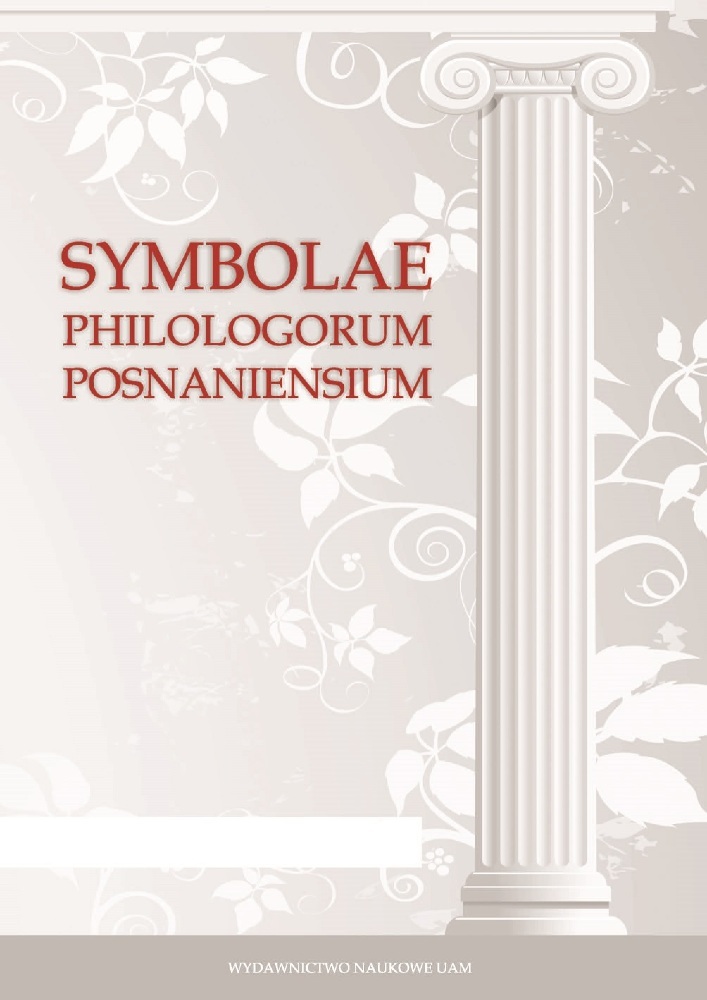Abstrakt
The text compares Roman ludi (mainly venationes), with Spanish tauromachy. Although there is no continuous
tradition there are some universal similarities in their elements. We illustrate this by means of three comparisons:
between the symbolical space of bullrings and amphiteatres, between the glory of gladiators and toreros
as well as its influence on the world art, and finally between the ancient and contemporary controversies that
led to a change or decline in both traditions.
Bibliografia
Źródła i przekłady:
Anonim, Anonima diariusz peregrynacji włoskiej, hiszpańskiej i portugalskiej (1595), wyd. J.
Czubek, Kraków 1925.
Augustyn św., Wyznania, przeł. J. Czuj, Warszawa 1954.
Corpus Inscriptionum Latinarum, Manfred G. Schmidt, Berlin 2001.
Cassius Dio, Roman History, Loeb Classical Library edition, vol. IX, przeł. E. Cary, Harvard 1927.
Festus Grammaticus, De la signification des mots, trad. M.A. Savagner, Panckoucke, 1846
[http://remacle.org/bloodwolf/erudits/Festus/t.htm] (dostęp 12.09.2016).
Gutierrez P.R., Descripción general de la Europa y sus estados, y Cortes, especialmente de España y Madrid antiguo y moderno, Madrid 1782.
Herrera G. A., Agricultura general, t. IV, Madrid 1819.
Marcial, Epigramas de Marco ValerioMarcial, Zaragoza 2004.
Marcjalis, Księga widowisk, przeł. Katarzyna Różycka-Tomaszuk, Wrocław 2015.
Seneka, Dialogi, przeł. L. Joachimowicz, Warszawa 1998.
Seneka, Listy moralne do Lucyliusza, przeł. W. Kornatowski, Warszawa 2010.
Tertulian, O widowiskach. O bałwochwalstwie, przeł. S. Naskręt, Poznań 2005.
Opracowania:
Baker 2002: A. Baker, Gladiatorzy, Warszawa 2002.
Brooke 2004: B. Brooke, Mexico’s Dance with Death, [http://therealmexico.com/bullfighting.
htm] (dostęp 25.06.2012).
Canter 1930: H.V. Canter, The Venerable Bede and the Colloseum, [w:] „Transactions and Proceedings of the American Philological Association” 61 (1930), Baltimore 1930, s. 150.
Conrad 2009: J.R. Conrad, El cuerno y la espada, Sevilla 2009.
Crawford 2000: B. Crawford, The History of Mexican Bullfighting, [http://www.ehow.com/about_5254963_history-mexican-bullfighting.html] (dostęp 15.06.2012).
Daza 1999: J. Daza, Precios manejos y progresos del arte del toreo, Sevilla 1999.
Delgado Linacero 2007: C. Delgado Linacero, Juegos taurinos en los albores de la historia, Madrid 2007.
Doménech Mira 2013: F.J. Doménech Mira, Charlas hispánicas en Hamburgo, Madrid 2013.
Dunkle 2008: R. Dunkle, Gladiators. Violence and Spectacle in Ancient Rome, New York 2008.
Flores Arroyuelo 2000: F.J. Flores Arroyuelo, Del toro en la antiguedad: Animales de culto, sacrificio, caza y fiesta, Madrid 2000.
García de Moral 2013: M. García de Moral, El día que Madrid se desfrazo de la antigua Roma [w:] Secretos de Madrid, 25.11.2013, [http://www.secretosdemadrid.es/el-dia-que-madrid-sedisfrazo-de-la-antigua-roma] (dostęp 20.07.2016).
Grant 1979: M. Grant, Gladiatorzy, Wrocław 1979.
Golden 2008: M. Golden, Greek Sports and Social Status, Texas 2008.
Gurpegui 1904: M. G. Gurpegui, Fuimos de fiesta y volvimos de entierro, „Diario Vasco” 1904, [http://www.diariovasco.com/v/20100724/san-sebastian/fuimos-fiesta-volvimos-entierro-20100724.html] (dostęp 20.07.2016).
Kocur 2005: M. Kocur, We władzy teatru. Aktorzy i widzowie w antycznym Rzymie, Wrocław 2005.
Kowalski, Rodriguez Núñez 1992: K. Kowalski, M. Rodriguez Núñez, Corrida, Warszawa 1992.
Krzemiński 2010: A. Krzemiński, Po byku. Katalonia żegna walki byków, „Polityka”, 20 sierpnia 2010, [http://www.polityka.pl/swiat/obyczaje/1507822,1,katalonia-zegna-walki-bykow.read] (dostęp 20.06. 2012).
Kyle 2007: D. Kyle, Sport and Spectacle in the Ancient World, Malden-Oxford 2007.
Larra 1828: M.J. Larra, Corridas de toros, „El Duende Satírico del Día”, 31 de mayo, Madrid
Lee Bomgardner 2000: D. Lee Bomgardner, The Story of Roman Amfitheatre, New York 2000.
Leiris 1999: M. Leiris, Lustro tauromachii, Gdańsk 1999.
Lipczak 2010: A. Lipczak, Krew z byka nie posika, „Polityka”, 21 stycznia 2010; [http://archiwum. polityka.pl/art/krew-zbyka-nie-posika,426698.html] (dostęp 20.06. 2012).
Lorca 2016: A. Lorca, Muere el torero Víctor Barrio tras sufrir una cornada, „El País” 9.07.2016, [http://cultura.elpais.com/cultura/2016/07/09/actualidad/1468090160_083972.html] (dostęp
07.2016);
Lorca 2016: A. Lorca, Cuarto encierro de San Fermín 2016: dos heridos
por asta, „El País” 10.07.2016, [http://cultura.elpais.com/cultura/2016/07/10/actualidad/
_415597.html] (dostęp 20.07.2016).
Lozano 1698: C. Lozano, Reyes nuevos de Toledo, Valencia 1698.
Ludorowski 2007: L. Ludorowski, Henryka Sienkiewicza podróż do Hiszpanii i „Walka byków”, Lublin 2007.
Monahgan 2003: P. Monahgan, Bloody Roman Narratives: Gladiators, „Fatal Charades” & Senecan Theatre Paul Monaghan, „Double Dialouges” 4, 2003, [https://minerva-access.unimelb.edu.au/bitstream/handle/11343/34640/67258_Bloody.pdf?sequence=1] (dostęp 10.09.2016)
Quílez 2007: R. Quílez, El Toro de Osborne, de icono publicitario a símbolo de la España cañí, [http://elmundo.es/elmundo/2007/010230cominicacion/1169557115.html] (dostęp 15.06.2012).
Sajkowski 2007: A. Sajkowski, Droga do Compostelli albo sto lat podróży Polaków do Hiszpanii [w:] Sarmackie tradycje i europejskie horyzonty, Poznań 2007.
Słapek 2010: D. Słapek, Sport i widowiska w świecie antycznym, Kraków-Warszawa 2010.
Todd 1939: F. A. Todd, Three Pompeian Wall-Inscriptions, and Petronius, „The Classical Review” vol. LIII, No. 1 (Feb. 1939), Cambridge1939.
Wiedemann 2002: T. Wiedemann, Emperors and Gladiators, London-New York 2002.
Varone 2002: A. Varone, Erotica Pompeiana. Love inscriptions on the Walls of Pompei, Roma 2002.
Zakrzewski 1973: J. Zakrzewski, Iberyjskie wędrówki, Warszawa 1973.
Licencja
